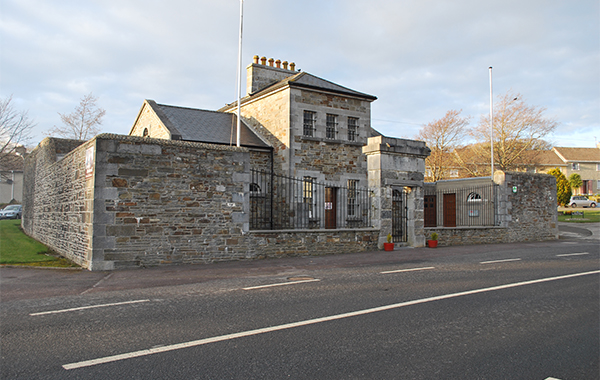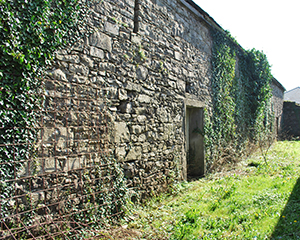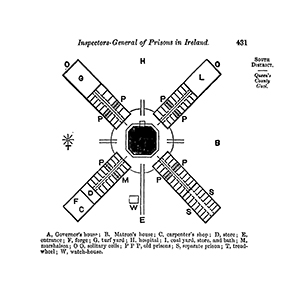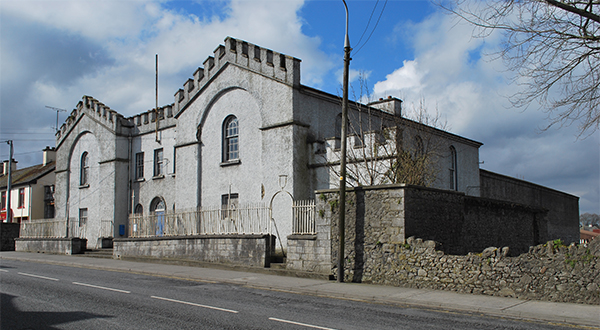A scene of shameful disorder and dissipation’
Published in Features, Issue 2 (March/April 2020), Volume 28Alcohol, music, animals and vegetables in early nineteenth-century Irish prisons.
By Richard Butler
James Palmer and Benjamin Woodward, the State’s prison inspectors in early nineteenth-century Ireland, faced a monumental challenge: all around the country, in big county gaols and in small bridewells, prison governors and wardens were a law unto themselves. Affairs were managed on a county-by-county basis, the running of a prison often passed from father to son, and new laws and ideas about prison reform coming from Dublin and London were, in general, quietly ignored. The annual reports of the Irish prison inspectors make for a sorry indictment of cans kicked down the road, suggestions not taken on board and appeals to the local landlords on county grand juries to take the running of their prisons a little more seriously.
Comedic disregard for the official regulations
They are also occasionally a pleasure to read, filled as they are with extraordinary and often comedic disregard for the official regulations, and creative indifference to the whole concept of using the prison as an environment for ‘moral reform’. Alcohol was frowned upon but readily available in most prisons. Some governors ran lucrative side-businesses keeping debtors almost permanently inebriated, as in the old marshalsea in Dublin. Others were more reckless and used parts of prisons for keeping animals, growing their own vegetables and even—in the odd case—storing weapons for the local yeomanry. Such activities continued for many decades despite annual condemnation by the prison inspectors. Their visits were nothing like the modern concept of an ‘unannounced inspection’; rather, word spread from town to town that the inspectors were doing their rounds, and the most egregious abuses of the law could be swept under the carpet until they had left. Yet in some cases it appears that prison governors did not even bother to spruce up their institutions for the visit of the inspector, allowing festivities in prison cells to continue unabated in full knowledge that there was little the inspectors could do. Life in prison in early nineteenth-century Ireland might have been, from time to time, an enjoyable experience. It might even occasionally have been fun.

Above: The former bridewell in Tarbert, Co. Kerry, built c. 1828–30, where a female cell was used as an arms depot for the local yeomanry.
For eighteenth-century prison reformers such as John Howard, however, prisons were sites of misery, vice and disease. When typhus—not medically understood at the time—tore through jails, it killed prisoners and staff; worse still, illness spread into nearby streets. In cramped alleyways, death in the prison meant death in the town. Howard and later reformers believed that modern jails needed to be entirely separate from their surrounding spaces. Incarceration and punishment would, they hoped, be conducted within a frame of ‘rational’ rules and regulations. ‘Abuses’—a word regularly employed at the time—would be eradicated with strong oversight and inspection. They hoped to make the physical and moral disorder of the old ‘dungeon’ prison as obsolete and repugnant as the slave ship. Thus new prisons were designed to allow careful inspection of prisoners and the separation of prisoners of different ages and sexes, and the jail itself was built to allow some ventilation and sunlight into cells and yards.
In early nineteenth-century Ireland this meant that the prison would be separated from the surrounding town, and irregular ‘private’ uses by staff and their families would be systematically eliminated. Any ‘rural’ traits of these urban institutions could not be tolerated: the prison inspectors banned the keeping of farm animals and called for the tearing up of vegetable gardens. In their somewhat naïve quest for a sterile carceral landscape of stone and gravel, they turned on grass yards as a source of moisture and, they believed, disease.

Above: A yard in the former bridewell in Boyle, Co. Roscommon, built 1826–8, once used as a cabbage patch.
Prisons (Ireland) Act, 1810
The 1810 Prisons (Ireland) Act formed the basis for the inspectors’ work. It stated that prison governors had to be men who were neither bakers nor brewers, who had no other business to distract them from their prison work and who resided in the prison. The sale of alcohol was banned outright. In great detail, the act set out the daily obligations of the keepers to clean the prison and light fires in the winter, to separate the sick from the healthy and to provide exercise yards. ‘No hogs, pigs, cattle, or poultry of any kind’, the act stated, ‘shall be kept in any yard of any prison.’ The Cork County grand jury went even further in their regulations for their new bridewells, built soon afterwards: a prison keeper’s employment depended upon the ‘habits of cleanliness in his family and in the prison’. ‘Care [was] to be taken’, the regulations continued, ‘that no stalls or buildings are erected against or within eight feet of the boundary walls of bridewells, which space is the property of the county and always to remain unoccupied.’
The boundary wall, then, became the first battle in the inspector’s desire to keep prisoners separate from the ‘sins’ of the world outside. Back in the 1780s, Howard noticed a prisoner in a Dublin jail playing tennis with ‘several of his idle companions’ who had been let in by the keeper. In Loughrea in the same years there were windows facing the street and alcohol was easily passed to prisoners, who were seen ‘drinking whiskey in a pint mug’. In the early 1820s Palmer and Woodward were horrified to find, in Youghal, ‘such being the indiscriminate and uncontrolled admission of visitors, that one person, who had been confined for three years, was permitted to keep a musical academy (a scene of shameful disorder and dissipation) in his miserable and close apartment’.
Things were not much better in Listowel, where the ‘indiscriminate admission of strangers into the [prison] house’ was so rampant that the inspectors were ‘unable to gain admittance until the crowd was removed’. In Kenmare the bridewell was part of a pub: it was ‘insecure as well as inconvenient, as the escape of two prisoners has lately proved; the prison is kept in a most filthy state, and the keeper appears to be quite incompetent’.

Above: Plan of Portlaoise gaol as originally built, 1827–30. A large kitchen garden had been set up there in the early 1830s. (Forty-eighth report … on … the prisons of Ireland, 1869, House of Commons, 1870)
The bridewell boundary wall did little, however, to stop wardens using prisons for their own private family or business interests. Often it was the female cells or yard that were requisitioned by staff, being, as per the proportion of crime committed by men and women, the part of any prison most often empty. In Tipperary town, in the politically febrile years of the late 1840s, the two female cells were in use as ‘[gun]powder stores’. In Stradbally, Co. Laois, the female room was ‘very improperly’ taken over by the keeper to churn milk. Perhaps most recklessly, one female cell in the bridewell at Tarbert was in use as ‘a Depot for Arms; being a misapplication of the building and placing it in danger’. These guns belonged to the local yeomanry and were stored by agreement between an unnamed local gentleman and the family who managed the bridewell. From the 1830s until well into the 1850s, the rusting guns remained in the damp female cells—along with, in later years, the keeper’s wife and children.
These kinds of transgressions, the inspectors argued, undermined the prison reform movement in these years, as well as public safety. Such ‘abuses’ were endemic and the inspectors in general failed to effect much change. In Adare there was turf in cells, in Navan sacks of corn and in Kells potatoes. ‘It is useless’, commented an exasperated Palmer, ‘to build prisons if the keeper is to allocate them for private purposes.’
Farm animals
For the inspectors, the keeping of farm animals inside prisons—including in prison cells—was an even greater concern. It violated the healthiness and separateness of the prison environment and constituted a gross contravention of the rules forbidding private use by keepers. Even in smaller market towns it brought the rural into the urban, undoing attempts to create a ‘healthy’ environment within the prison walls. Animals could bring diseases into prisons; their care distracted keepers from their official responsibilities; and their produce brought unregulated financial gain. Pigs were the main culprits. Back in 1782, Howard noticed that the yard at Trim county gaol was ‘the gaoler’s pig-sty’. Palmer and Woodward found pigs in many bridewells: following an inspection of the bridewells in Newcastle West and Croom, for example, Woodward suggested by way of punishment a reduction of £1 in the keepers’ salaries (a 10% cut). In nearby Ballingarry he commented that ‘nothing can exceed the filth and irregularity of the prison, the centre hall of which is used as a pig-stye’.
Cows, too, were found inside Irish prisons: in the insulating passage adjacent to the boundary walls at Galway county gaol in the 1820s, the keeper maintained a ‘flower-garden, cabbages, potato field, cows, &c &c, contrary to every principle of prison discipline’. In Belfast bridewell, milk from prison cows was being stored in some of the cells. As keepers purchased large quantities of milk to feed prisoners—at the expense of the county—there were clear financial incentives to produce and supply milk internally: in Coleraine in 1841 another prison inspector, Francis White, noted that ‘the keeper has a cow and supplies the milk himself. Whether this ought to be allowed seems questionable, and requires the attention of the Local Prison Authorities, lest it may lead to abuse.’ Keepers also earned money from keeping chickens: in Ballinamore during the Famine years one cell had been ‘dirtied’ by poultry.

Above: The former bridewell (and courthouse) in Birr, Co. Offaly, built c. 1810. Its overgrown yards made an unhappy marriage with a hopelessly dysfunctional sewage system.
Removing animals from prisons could easily be justified in terms of hygiene and sanitation. The same was less true for vegetables, but the inspectors tried their best to eradicate these from yards and passages. In Portlaoise’s new county gaol in the early 1830s, Palmer noticed:
‘A large kitchen garden has been made within the walls of the prison, a thing unusual if not illegal, which is considered more objectionable by being made a source of profit. I was quite distressed at finding it not unusual for inhabitants of the town to call at the county gaol to purchase a few pennyworths of cabbages: but this is not even the worst effect of this practice, it opens a door for all manner of abuse and want of discipline, by bringing prisoners of all classes and crimes together to work for the proprietor of the garden. I found some persons under sentence of hard labour actually at this work, with a turn-key employed to sell the vegetables … I should urge the Board [of Superintendence] to abolish the whole garden, with the exception of a flower-garden in the front, and to have the surrounding walk gravelled.’
(What Palmer would think of the high-security defences in front of the prison today is hard to imagine.) It was similar elsewhere: a garden in Ballinrobe bridewell, a cabbage plot in Boyle and rows of potatoes in Kilrush. At no time was this battle against vegetation more apparent than during the Famine. The inspectors launched a new crusade against—of all things—grass in the prison. They thought that grass growing in the bridewell in Milltown, Co. Kerry, was ‘objectionable’ because of its ‘retaining damp and being slovenly’. One of the most offensive, they thought, was Birr, where overgrown yards made an unhappy marriage with a hopelessly dysfunctional sewage system:
‘The two yards are overgrown with grass and weeds, the privies are falling down and in a filthy state, and the keeper cannot preserve order unless a general repair takes place.’
Yet little action was taken and the inspectors’ report from a few years later was no less alarming. Prison inspectors in early nineteenth-century Ireland had their work cut out for them: limited by the autonomy of local government and private arrangements with individual families and friends, there was little they could do to make prisons the idealised spaces that they imagined. There was a certain desperation in their reports, and much tragedy, but occasionally some comedy. We might reserve some pity for Palmer, who has the ignominy, it would appear, of being the only Irish prison inspector to have himself been locked up: some reckless property speculations sent him to the debtor’s yard at Kilmainham. Upon release, he implausibly resumed his work trying to convince the jail’s staff to improve their prison.
Richard Butler is a lecturer in the historic built environment at the University of Leicester.
FURTHER READING
R. Butler, Building the Irish courthouse and prison: a political history, 1750–1850 (Cork, 2020).
R. Evans, The fabrication of virtue: English prison architecture, 1750–1840 (Cambridge, 1982).
M. Rogan, Prison policy in Ireland: politics, penal-welfarism and political imprisonment (London, 2011).
J. Starr, ‘Prison reform in Ireland in the age of enlightenment’, History Ireland 3 (2) (1995), 21–5.
















